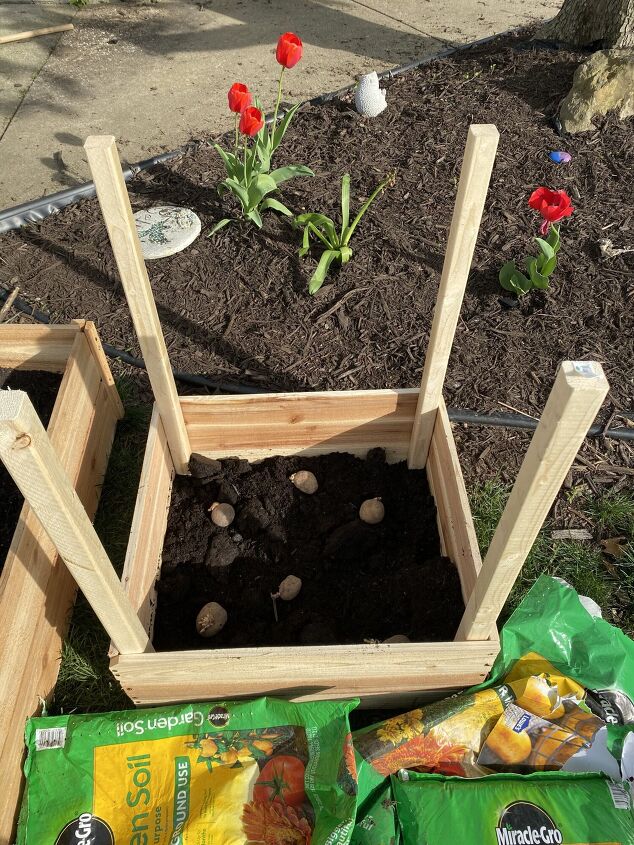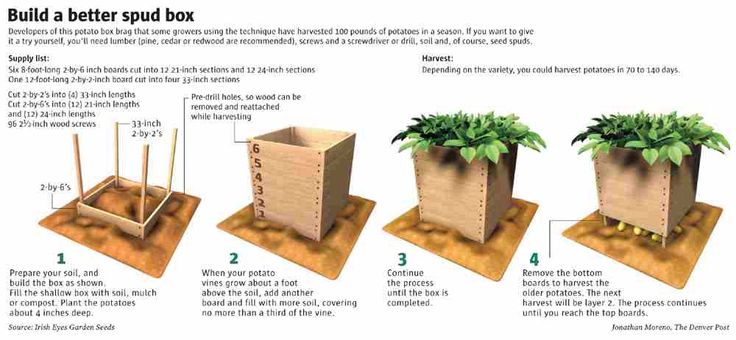Food prices are going up, so being able to grow your own food instead of buying it from the store is helpful. Potatoes are a great thing to grow in your garden or raised bed right now because they are so easy. It doesn’t matter how big or small your garden is; anyone can grow potatoes in a potato box.
We have a lot of space, but the chickens need it all, so we grow our potatoes up instead of down to save room. Potato boxes allow you to grow potatoes with minimal space and still produce high yields.
Last year, Mike built me some potato boxes. If you want to make some for your garden, he’ll show you how to do it below!
Growing potatoes in a potato box is a fun and productive way to add this staple crop even in a small garden. Potato boxes allow you to grow a lot of potatoes in a compact vertical space. Follow this step-by-step guide to easily construct your own custom potato growing box at home.
Potato Box Building Materials
Constructing a potato box is a fairly simple woodworking project You’ll need the following materials
- 2-3 eight foot 1″x6″ boards
- 2-3 eight foot 2″x2″ boards
- Wood screws or nails
- Drill with various drill bits (if using screws)
- Saw – hand saw, miter saw, etc.
- Tape measure and pencil
- Sandpaper (optional)
- Wood glue (optional)
We’ll break the construction process down into easy steps, but first let’s go over some potato box design tips.
Potato Box Design Tips
- Standard size is around 24″x24″x30″, but dimensions can vary. Bigger is better for increased yields.
- Use rot-resistant wood like cedar or pine. Avoid treated lumber.
- Include drainage holes in the bottom and ventilation holes up the sides.
- Make sure boards are straight and corners square for stability.
- Add an open bottom frame to elevate the box off the ground.
- Optional: paint or stain for decoration and wood protection.
Now let’s get building!

How to Construct a Potato Box
Grab your materials and tools. Safety first – wear gloves, eye protection, etc. Let’s build a potato box:
1. Cut the boards
Cut two 2″x2″x8′ boards into:
- 4 pieces 33″ long (legs)
- 8-10 pieces 21″ long (end frames)
Cut two 1″x6″x8′ boards into
- Enough 24″ long slats for the sides
2. Assemble the end frames
Attach 21″ boards to legs with screws or nails to create two end frame pieces, Attach cross-boards about 4″ up from bottom, Predrill holes if using screws
3. Add side slats
Attach 24″ 1×6 slats vertically to the end frames using nails or screws. Leave 1-2″ gaps between slats for ventilation.
4. Add bottom (optional)
For a solid bottom, attach 24″x24″ board or hardware cloth screen to bottom of end frames. Or leave open.
5. Include drainage and ventilation
Drill several 1″ holes in bottom for drainage. Drill ventilation holes up the sides if desired.
6. Sand and finish (optional)
Lightly sand any rough edges. Apply protective stain or paint if desired. Let dry fully before using.
That’s it – you now have a sturdy DIY potato box ready for planting! The vertical slats allow you to add planting mix and mound potatoes as the plants grow taller.
Getting Started Growing Potatoes in a Box
Once your potato box is built, it’s time to start growing potatoes! Follow these tips:
- Fill box with 8-12 inches of planting mix or compost.
- Plant seed potatoes every 6 inches in a grid pattern. Place cut side down.
- Cover potatoes with 4 inches of soil. Water well.
- Once plants are 8 inches tall, add more soil/compost leaving 4 inches of plant exposed.
- Repeat this hilling process until box is full.
- Water when soil dries out. Avoid overwatering.
- Harvest potatoes when plants start dying back in summer/fall.
That’s all there is to it! With a simple DIY potato box, anyone can grow pounds of potatoes in a small footprint. Customize dimensions to your space and needs. Add vertical growing space by pairing boxes with a trellis or teepee structure. Get creative and enjoy the easy bounty of homegrown potatoes!
Tips for Building a Potato Box
Did you know that Home Depot can cut boards to the lengths you need? You have to buy the boards there, and you might have to wait a little while. It’s best to go shopping at a less busy time of the day or week if you need them to cut your boards for you.
I am using a drill and screws because I have a drill available to me. But, if you do not have a drill, this project can be completed with a hammer and nails. Adjust the supply list accordingly from screws to nails when using a hammer. Be sure to measure so you purchase nails long enough to go through the board and securely attach it to the post. If you are in need of a drill I have my favorite drill listed in our Amazon Storefront.
Amy and I usually get a few different kinds of potato starts at the nearby greenhouse. I also usually add a few organic seed potatoes that have begun to grow from the potatoes we already have at home. I recommend growing the potatoes you like to eat. You could grow different kinds of potatoes in different beds. That way, you’ll always know which box has which kind of potato in it. Keep it simple and don’t overthink it.
When it comes to growing conditions, potatoes grow best in sandy, well-drained soil. You can run a soil test to see if you have good soil or need to add amendments. They also grow best in full sun. The amount of water will vary depending on your location and the timing of when you plant.
How many potatoes you can plant in each potato box will depend on the type of potato and its level of growth. You do not want to inhibit plant growth by having too many seed pieces in one area. The best way to plant potato starts is to follow the directions on the package for each type you want to grow.
DIY: How To Make Potato Growing Boxes
FAQ
What is the box method for potatoes?
How big should a potato box be?
How do you grow seed potatoes in a box?
Place your seed potatoes in the box – with the sprout/eye facing up. Make sure the potatoes are 4-5″ apart. Cover with 1″ of soil. Then completely saturate the soil by turning on the water (attach the hose to your potato hose!) Once saturated, water your potato box every 2-3 days.
How do you build a potato box?
Use 2×6 slats to build the square frames for the planter box. Drill pilot holes at both ends of the 24″ long components and insert 2 1/2″ screws into the perpendicular ones. Make sure the corners are square before inserting the screws and check if the edges are flush. Next, you need to build the corner posts for the potato box.
Can you grow potatoes in a potato box?
Potato boxes allow you to grow potatoes with minimal space and still produce high yields. Mike built me a few potato boxes last year, so he’s going to explain that process below if you’d like to build some for your garden! Save Square Feet, Grow Vertically in a Potato Box! For a few years we’ve talked about building new potato boxes.
What is a potato growing box?
The idea is ingenious; forcing the potato plant to “stretch” upward as it grows allows more area of the plant to produce potatoes. The potato “growing” box is just that—a series of frames that stack, or grow, as the potato plant grows. I like to look at the frames as resembling the floors of a building.
- The Ultimate Guide to Growing Strawberries in Raised Beds - August 8, 2025
- No-Dig Garden Beds: The Easiest Way to Grow a Beautiful Garden - August 6, 2025
- How to Protect and Preserve Wood for Raised Garden Beds - August 6, 2025

